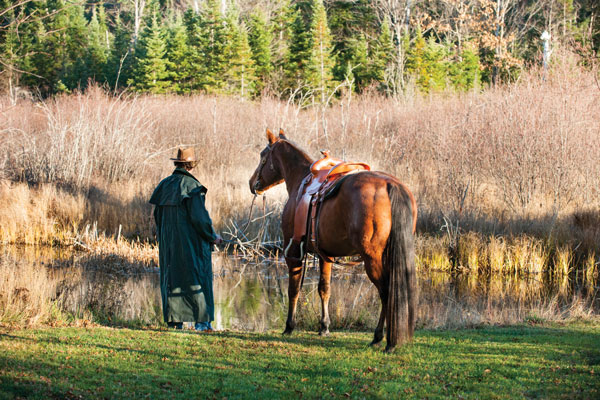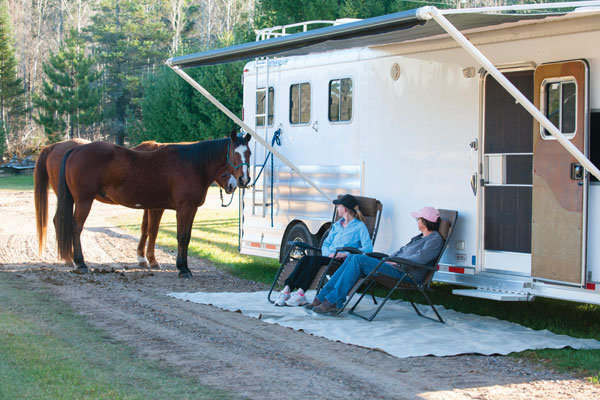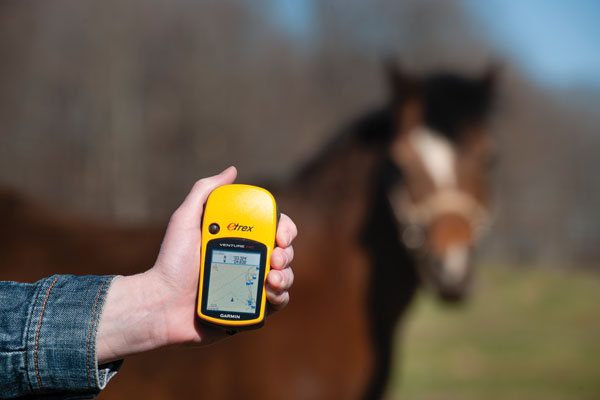
Summer and fall are fine times of year to get out of the arena and onto the trail for some new scenery. But some of the most interesting and exciting places to go horseback riding on the trail may lead you into terrain where cell service coverage gives you a spotty signal or even non-existent.
Two-Way Radios
Easy two-way communication has been available for decades using one of the simplest technologies available—radio. Sometimes referred to by the more playful term “walkie-talkies,” two-way radios can be an excellent method of short-distance communication in locations where cell service is unavailable.
They’re not quite as easy to use as cell phones, as you and your partner have to take turns talking and can’t speak over each other at the same time. Nevertheless, two-way radios are compact, reliable and fairly inexpensive. Despite the name, you can add multiple radios to a two-way setup, so that each rider in your group can carry one and stay in touch even if you can’t see each other. It’s also useful to leave one radio with a person back “home” (wherever that may be) who isn’t going on the ride.
The only real drawback is that two-way radios have a fairly restricted working range that is limited by the terrain (hills, trees, et cetera). While these radios can theoretically offer ranges of 30+ miles, in real-life scenarios you’ll likely get clear reception for only a handful of miles. Still, that may be sufficient for your ride. And because of the restricted distances, you probably won’t need an FCC license to use these devices (as you might for other types of amateur radios).

AM/FM Radios
Even when you’re out of cell range for a signal when horseback riding, regular old AM/FM radio can function well in remote locations. Obviously, it’s a one-way form of communication, so you can’t use it for sending messages. But AM/FM is still very useful for receiving information like local weather reports and news—not to mention keeping you supplied with music! And in case of severe weather or some other unanticipated event, AM/FM broadcasting can be a reliable source of information.
AM/FM radios are quite inexpensive and small enough to carry easily, so it makes sense to pack one on a ride. FM radio has a shorter range (only about 100 miles or less) but is less susceptible to static, although the signals can be blocked by terrain. AM radio tends to travel much further, especially at night, and will reach into even the most remote locations. It’s a lot more susceptible to static, however.
Satellite Phones
If you’re a serious trail rider who regularly spends time in areas without cell service, a satellite phone might be a worthwhile investment for safety and convenience. Unlike a traditional cell phone, satellite phones communicate through space—not cell towers—and therefore should function no matter where you are, as long as there is a line-of-sight view of the sky. No more searching for cell signals!
Satellite phones can help give you confidence that if an emergency or other problem occurs, you’ll be able to reliably call for help. The downside is that satellite calls can be quite a bit more expensive per minute than traditional phones, so you won’t want to use these phones to shoot the breeze.

Satellite Messengers
If you’re looking for something less expensive to purchase and operate, you might try a satellite messenger. Like a cell phone sending a text message, satellite messengers can do the same thing, except that the signal goes through space, so they work almost anywhere there is a clear view of the sky.
These devices permit you to convey at least basic information (“We made it to camp.”), at a considerably lower cost than using a satellite phone. Satellite messengers are popular with backpackers and other outdoor enthusiasts.
Personal Locator Beacon (PLB)
Another safety option is a PLB, which is essentially a simple satellite device with one button. That button, when pressed, will transmit your location and a generic SOS message to rescue crews, who will move into your location ASAP.
Be careful not to press the button by mistake, as once you’ve sent the message, there’s no calling it back. These devices are intended to be used only in serious emergency situations, but they’re easy to pack and provide peace of mind.
Global Positioning System (GPS)
Hey—your cell phone has a GPS app, right? But will it function without a cell signal? Actually, yes. GPS uses satellite signals—not cell towers—to get a fix on your location, so your smartphone can help you find your way even when you’re at zero bars. But be sure to download your app’s maps before you leave home. Alternatively, you could pack a dedicated handheld GPS and achieve the same results.
Either way, play it smart and also carry a good map of your area and a regular old compass. Electronics are wonderful until they don’t work, so maps are a smart backup.

Take it Easy
Finally—share your plans. Determine an itinerary (your planned route and timeline) and leave it with someone back in “civilization.” And stick with your plan—no one back home will know about deviations (“let’s check out that lake down there”), unless, of course, you’re able to communicate with them using one of the methods already mentioned.
Also, it’s important to keep any device on your person and not in a saddle bag or somehow attached to your horse, in case you and your horse are separated and he heads for home. So when trail riding, ride with a friend, take it easy, and have fun. Over and out!
This article about horseback riding with no cell signal appeared in the August 2020 issue of Horse Illustrated magazine. Click here to subscribe!





